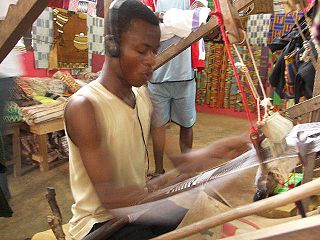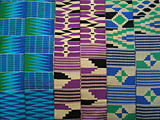
Stripweave
Encyclopedia


Textile
A textile or cloth is a flexible woven material consisting of a network of natural or artificial fibres often referred to as thread or yarn. Yarn is produced by spinning raw fibres of wool, flax, cotton, or other material to produce long strands...
technique in which large numbers of thin strips of cloth are sewn together to produce a finished fabric. Most stripweave is produced in West Africa from handwoven fabric, of which the example best known internationally is the kente cloth
Kente cloth
Kente cloth, known locally as nwentoma, is a type of silk and cotton fabric made of interwoven cloth strips and is native to the Akan people of Ghana and the Ivory Coast.- Etymology :...
of Ghana
Ghana
Ghana , officially the Republic of Ghana, is a country located in West Africa. It is bordered by Côte d'Ivoire to the west, Burkina Faso to the north, Togo to the east, and the Gulf of Guinea to the south...
.
The earliest evidence of this traditional technique dates to the eleventh century among the Tellem
Tellem
The Tellem were the people who inhabited the Bandiagara Escarpment in Mali. The Dogon people migrated to the escarpment region around the 14th century. The Tellem were pygmies or "small red people" who built dwellings around the base of the escarpment as well as directly into the cliff-face. Many...
people of Mali
Mali
Mali , officially the Republic of Mali , is a landlocked country in Western Africa. Mali borders Algeria on the north, Niger on the east, Burkina Faso and the Côte d'Ivoire on the south, Guinea on the south-west, and Senegal and Mauritania on the west. Its size is just over 1,240,000 km² with...
.

